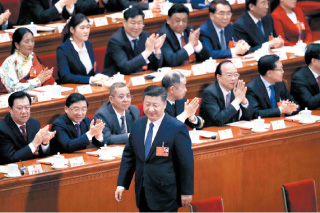The specter of centralism

Delegates applaud as Chinese President Xi Jinping walks to his seat after casting his vote for an amendment to China’s constitution that will abolish term limits on the presidency and enable him to rule indefinitely, during a plenary session of the National People’s Congress at the Great Hall of the People in Beijing. [AP/YONHAP]
The long socialist tradition of so-called democratic centralism was also a factor. The theory is that ideological differences are allowed during the decision process, but once a choice has been made no opposition is allowed. Karl Marx and Friedrich Engels defined democratic centralism as a centralized system that needs to be implemented temporarily during a proletariat dictatorship, a stepping stone on the journey to a communist society.
It was Russian revolutionary leader Vladimir Lenin who developed it as an actual organizational theory. In Lenin’s time, the democratic concept of electing leaders through votes was mixed with the centralization principles of hierarchical obedience. In the Stalin era, it went further. Absolute obedience to the party was required, and minor opinions were ignored to keep a unified state direction. Democratic centralism was used as a justification to purge opponents such as the Trotsky faction.
The Chinese Communist Party maintains democratic centralism as a party principle. In the 1954 Constitution, Mao Zedong defined the four principles of democratic centralization: The minority’s obedience to the majority, individual obedience to the group, subordinates’ obedience to a higher authority and the party’s obedience to central principles. North Korea established a leadership theory that its head is the “highest brain of the working people and the center of unification and unity” and served the leader like an absolute monarch. In the 1980s and 90s, some activist groups, such as the National Conference of Student Associations, were influenced by democratic centralism and had a culture of excessively admiring leaders as heroes.
Democratic centralism is the organizational theory of socialist states and parties, but this can lead to dictatorship. The strongest warning came from within socialism. Rosa Luxemburg, a theoretical opponent of Lenin, said that democratic centralism was not a proletariat dictatorship, but the dictatorship of the proletariat.
Trotsky argued that Lenin’s democratic centralism would substitute the part for the proletariat, the Central Committee for the party and finally the dictator for the Central Committee.
The specter of democratic centralism, where democracy is gone and only centralism remains, is still haunting the Korean Peninsula.
JoongAng Ilbo, Mar. 13, Page 31
*The author is an editorial writer of the JoongAng Ilbo.
SUH KYOUNG-HO










with the Korea JoongAng Daily
To write comments, please log in to one of the accounts.
Standards Board Policy (0/250자)